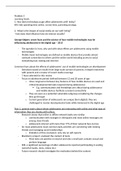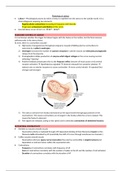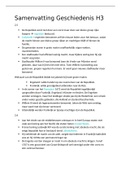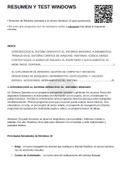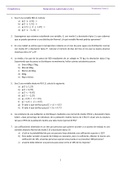Problem 5
Learning Goals:
1. How does technology usage affect adolescents well- being?
KW: kids spending time online, screen time, parenting strategy
2. What is the impact of social media on our well- being?
- how does that influence how we interact socially?
George-Odgers: seven fears and the science of how mobile technologies may be
influencing adolescents in the digital age – 2015
- The question is: how, why and with what effects are adolescents using mobile
technologies
- Mobile (new) technologies are defined as mobile devices that provide almost
constant connection to others and the online world including access to social
networking tool, texting and internet
Common fears about the effects of adolescents’ use of mobile technologies on development
- Selections based on results from large-scale surveys of parents, in-depth interviews
with parents and a review of recent media coverage
- 7 fears selected for this review
- Focus on adolescent period: defined between 12 and 20 years of age
o close congruence between key features of how mobile devices are used and
critical developmental tasks required during adolescence
E.g. communication and friendships are critical during adolescence
and mobile devices facilitate constant connectivity
o They are seen as a potential vulnerable subgroup considering the changes
they go through
o Current generation of adolescents are unique (born digital), they are
challenged to master developmental tasks while immersed in the digital age
Fear 1: parents worry about whom adolescents are interacting with online and what type of
information they are sharing with others
- Research shows that online vs offline network looks very similar
o communication with strangers is infrequent and most online messages are
among close friends
o adolescents interact with more than 77% of their network face-to-face
- for most adolescents most common daily activities are connecting with existing
friends and managing social relationships
o limitation of this conclusion: only rely on self-reports
- Blackberry project: analyzed the content of texts
o Most texts are positive or neutral and only a small part contains sexual and
profane language
- Still, a significant percentage of older adolescents reported participating in sexting
(semi/full nudes, texts, videos etc.)
- Future research should investigate the motivation behind the content
, Fear 2: parents fear that their children will be victims of cyberbullying or will be solicited by
strangers online
- Online safety is one of the most frequently cited concerns by parents
- It’s more difficult to monitor than traditional bullying and allows perpetrators to
remain anonymous
- Cyberbullying: aggression that’s intentionally and repeatedly carried vis electronic
mediums
- Adolescents victims are around 10% -40%
- There’s overlap between those who bullies offline and online, similarly there’s
overlap of the victims online and offline 90%
o Meaning many youths that’re at risk for cyberbullying are also at risk of
traditional bullying
- Adolescents who experience cyberbullying are at increased risk of mental and
physical health problems
o Cyberbullying relates more to suicide than traditional bullying
- However, significantly more youths are involved in traditional bullying than
cyberbullying
- There are no significant increases in cyberbullying involvement
- Even though there’s a lower prevalence there are still many negative outcomes such
as embarrassment, worry, fear, depression, loneliness, self-harm etc.
- LGBT youths report more frequent online attacks than heterosexual youths
- Many adolescents report not wanting to snitch on peers and think adults can’t help
the situation, one of the reasons being they fear parents will take their devices away
- New strategies are needed to create safe environments for victim closures
- One of the most common fears among parents is their child being victimized by a
stranger but this chance relatively low and targeting is not random
- Interactive component of exchanges with strangers in combination with offline risks
(e.g. substance use) is most predictive of harassment
Fear 3: adolescents’ constant connectivity prevents them from being present in real like and
interferes with offline socialization experiences and friendships
- Research for the last decade reports adolescents who report more frequent online
communication also report higher quality friendships
- Greater ease of online self-disclosure accounts for positive associations observed
between online communication and social connectedness
- do online tools strengthen existing relationships or adolescents with stronger
relationships have more frequent online interactions?
o Children with strong relationships early in life are more likely to use online
communication in adolescence – ‘rich get richer’
- Online exchanges help adolescents to bounce back emotionally after social rejection
or isolation
- Time spent online may be beneficial for skill building and enhanced well-being
- Online interactions could also mark and aggravate problems like existing mental
health problems
- Lower friendship quality and use technology for entertainment linked to
loneliness and isolation
Learning Goals:
1. How does technology usage affect adolescents well- being?
KW: kids spending time online, screen time, parenting strategy
2. What is the impact of social media on our well- being?
- how does that influence how we interact socially?
George-Odgers: seven fears and the science of how mobile technologies may be
influencing adolescents in the digital age – 2015
- The question is: how, why and with what effects are adolescents using mobile
technologies
- Mobile (new) technologies are defined as mobile devices that provide almost
constant connection to others and the online world including access to social
networking tool, texting and internet
Common fears about the effects of adolescents’ use of mobile technologies on development
- Selections based on results from large-scale surveys of parents, in-depth interviews
with parents and a review of recent media coverage
- 7 fears selected for this review
- Focus on adolescent period: defined between 12 and 20 years of age
o close congruence between key features of how mobile devices are used and
critical developmental tasks required during adolescence
E.g. communication and friendships are critical during adolescence
and mobile devices facilitate constant connectivity
o They are seen as a potential vulnerable subgroup considering the changes
they go through
o Current generation of adolescents are unique (born digital), they are
challenged to master developmental tasks while immersed in the digital age
Fear 1: parents worry about whom adolescents are interacting with online and what type of
information they are sharing with others
- Research shows that online vs offline network looks very similar
o communication with strangers is infrequent and most online messages are
among close friends
o adolescents interact with more than 77% of their network face-to-face
- for most adolescents most common daily activities are connecting with existing
friends and managing social relationships
o limitation of this conclusion: only rely on self-reports
- Blackberry project: analyzed the content of texts
o Most texts are positive or neutral and only a small part contains sexual and
profane language
- Still, a significant percentage of older adolescents reported participating in sexting
(semi/full nudes, texts, videos etc.)
- Future research should investigate the motivation behind the content
, Fear 2: parents fear that their children will be victims of cyberbullying or will be solicited by
strangers online
- Online safety is one of the most frequently cited concerns by parents
- It’s more difficult to monitor than traditional bullying and allows perpetrators to
remain anonymous
- Cyberbullying: aggression that’s intentionally and repeatedly carried vis electronic
mediums
- Adolescents victims are around 10% -40%
- There’s overlap between those who bullies offline and online, similarly there’s
overlap of the victims online and offline 90%
o Meaning many youths that’re at risk for cyberbullying are also at risk of
traditional bullying
- Adolescents who experience cyberbullying are at increased risk of mental and
physical health problems
o Cyberbullying relates more to suicide than traditional bullying
- However, significantly more youths are involved in traditional bullying than
cyberbullying
- There are no significant increases in cyberbullying involvement
- Even though there’s a lower prevalence there are still many negative outcomes such
as embarrassment, worry, fear, depression, loneliness, self-harm etc.
- LGBT youths report more frequent online attacks than heterosexual youths
- Many adolescents report not wanting to snitch on peers and think adults can’t help
the situation, one of the reasons being they fear parents will take their devices away
- New strategies are needed to create safe environments for victim closures
- One of the most common fears among parents is their child being victimized by a
stranger but this chance relatively low and targeting is not random
- Interactive component of exchanges with strangers in combination with offline risks
(e.g. substance use) is most predictive of harassment
Fear 3: adolescents’ constant connectivity prevents them from being present in real like and
interferes with offline socialization experiences and friendships
- Research for the last decade reports adolescents who report more frequent online
communication also report higher quality friendships
- Greater ease of online self-disclosure accounts for positive associations observed
between online communication and social connectedness
- do online tools strengthen existing relationships or adolescents with stronger
relationships have more frequent online interactions?
o Children with strong relationships early in life are more likely to use online
communication in adolescence – ‘rich get richer’
- Online exchanges help adolescents to bounce back emotionally after social rejection
or isolation
- Time spent online may be beneficial for skill building and enhanced well-being
- Online interactions could also mark and aggravate problems like existing mental
health problems
- Lower friendship quality and use technology for entertainment linked to
loneliness and isolation


